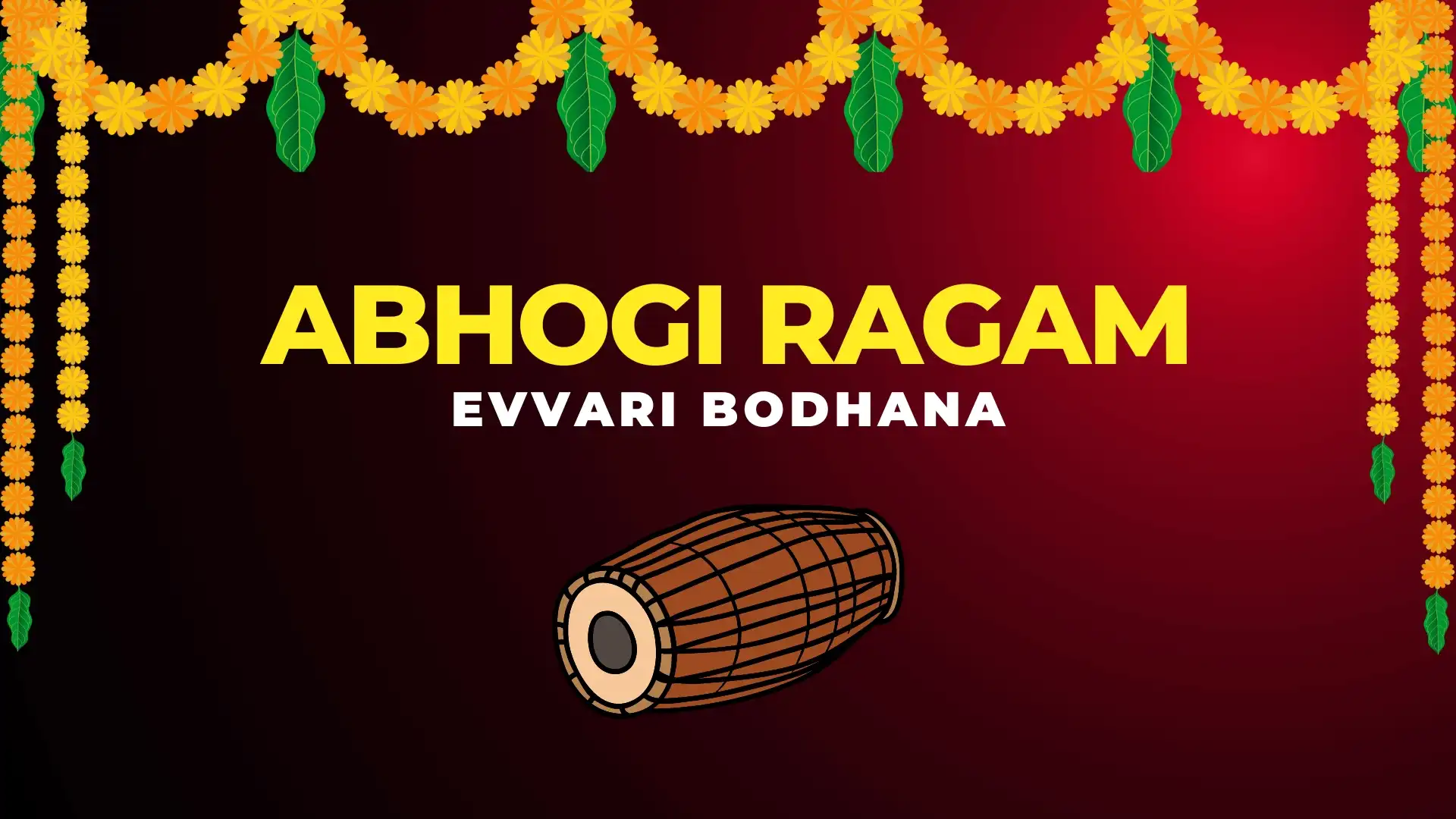An Introduction
Abhogi Varnam – Evvari Bhodhana is a most sung among Carnatic Musicians. Abhogi Ragam is categorized as Audava Ragam (it’s set in a Pentatonic Scale). This Ragam is classified under Janya Raga, which means it does not contain all the swaras. Panchamam and Nishadham (Pa & Ni) are missing in this Ragam. This particular Ragam has 5 scales in Aarohanam and Avarohanam each, and hence Abhogi Ragam is an Audava-Audava ragam.

Raga Kalavati is a transposition of Abhogi – P.Moutal.
A varnam is a composition that imbibes all the characteristics of a Ragam. It is also the element that decides the foundation in Carnatic Music. This enables the learning curve to reach Keerthnais efficiently. Varnams takes the learner through the process of learning set swaras in the ragam, special usage of those set swaras. Varnam enunciates the main notes of a ragam. Aalapana, Kalpana Swarams and Neravals becomes easy when one masters Varnam.
Structure of Abhogi Ragam
The notes used in Abhogi Ragam are, shadjam, chathusruti rishabham, sadharana gandharam, shuddha madhyamam and chathusruthi dhaivatham. Abhogi ragam is a Janya Ragam of the Kharaharapriya order, the 22nd Melakartha Ragam in the series. Abhogi Ragam can also be derived from Gourimanohari, by dropping the Pa and NI from the notes.

Did You Know?
Abhogi Ragam is also found in Hindustani and it gets classified under Kafi Thaat.
Meaning of Evvari Bodhana
Abhogi Varnam, Evvari Bodhana, is an imploration to Lord Srinivasa, residing in the divine hills of Tirupathi. The singer asks the Lord, on whose order is he acting. They implore the lord of the hills, which is believed to be Adishesan, Lord’s serpant, in the form of the hills. It is an open call for the Almighty to come and rule the lives. This imploration is because, there is sufferening caused by the actions of Cupid and that only Lord Srinivasa can save them.
Notation
Ragam : Abhogi
Talam: Adi
Composer: Patnam Subramaniya iyer
Aroganam: S R2 G2 M1 D2 Ṡ
Avaroganam: Ṡ D2 M1 G2 R2 S
Pallavi
| R | , | G | , | | G | R | S | , | | S | R | S | S | | Ḍ | Ṃ | Ḍ | , | | |
| Ev | – | va | – | | ri | – | – | – | | bo | – | – | – | | dha | – | – | – | | |
| Ṃ | Ḍ | S- | Ḍ | | , | S- | Ḍ | S | | R | G | ,- | M | | G | G | R | S | || |
| na | – | – | – | | – | – | vi | – | | – | – | – | ni | | – | – | – | – | || |
| R | G | M | G | | , | M- | R | G | | S | R | ,- | D | | S | R | G | M | | |
| ee | – | – | – | | – | – | la | – | | – | – | – | gu | | – | – | – | – | | |
| D | M | D | Ṡ | | , | Ṡ | D | Ṡ | | | D | M | ,- | G | | M | G | Ṙ | S | || |
| je | – | – | – | | – | – | se | – | | | – | – | – | vu | | – | ra | – | – | || |
Abogi Anupallavi
| Ṡ | Ṡ | D | D | , | M- | D | D | M- | G | , | R | G | M | R | G | | | |||
| Ja | – | – | va | – | – | mu | – | – | ga | – | – | nan | – | – | – | | | |||
| S | R | G- | M | , | M- | D | M | | | G | R- | G | M | D | D | S | , | || | ||
| ne | – | – | la | – | – | ra | – | | | – | – | She | – | sha | – | – | – | || | ||
| D | Ṡ | Ṙ | Ṡ | , | Ṙ | Ġ | Ṁ | Ṙ | Ġ | ,- | Ṁ | Ġ | Ġ | Ṙ | Ṡ | | | |||
| cha | – | – | le | – | – | ndra | – | – | – | – | Shri | – | – | – | – | | | |||
| Ṙ | Ġ | Ṙ | Ṡ | Ṙ | D | Ṙ | Ṡ | | | Ṡ | D | M- | D | M | G | R | S | || | ||
| Ven | – | – | – | – | ka | – | – | | | te | – | – | shva | – | ra | – | – | || |
Abogi Muktayi Swaram
| R | G | M | R | , | G- | S | R | G | S | , | R | S | Ḍ | M | Ḍ | | | |||
| S | Ḍ | S | R | ,- | R | G | S | | | R | M | ,- | D | M | G | R | S | || | ||
| R | G | M- | G | , | M | D | M | D | Ṡ | ,- | Ṙ | Ġ | Ṡ | Ṙ | Ġ | | | |||
| Ṁ | Ġ | Ṙ | Ġ | , | Ṙ | Ṡ | D | | | Ṙ | Ṡ | ,- | D | M | G | R | S | || |
Charanam
| M | , | D | M | | D | , | , | , | | D | Ṡ | D | M | | D | D | Ṡ | , | | |
| Ma | – | ru | – | | ba | – | – | – | | – | – | – | – | | ri | – | – | – | || |
| D | Ṡ | D | D | | M | ,- | G | M | | G | R | S- | R | | G | S | R | G | | |
| Ko | – | – | – | | rva | – | ja | – | | | la | – | – | nu | | – | ra | – | – | || |
Chittai Swaram
| 1 | M | , | , | , | , | ,- | D | , | M | , | D | , | , | ,- | Ṡ | , | | | |||
| D | , | M | , | , | ,- | G | , | | | R | , | S | , | R | , | G | , | || |
| 2 | M | D | Ṡ | D | , | M- | D | M | G | R | ,- | G | M | G | R | S | | | |||
| Ḍ | S | ,- | R | G | M | D | Ṡ | | | ,- | D | M | R | R | S | R | G | || |
| 3 | D | Ṡ | D | M | G | R- | G | M | D | M- | G | R | G- | S | R | S | | | |||
| R | G | M | D | Ṡ | Ṙ | Ġ | Ṙ | | | Ṡ | D | M- | G | R | S | R | G | || |
| 4 | s | , | , | Ṡ | , | s- | Ṙ | Ġ | Ṡ | Ṙ | ,- | R | Ṡ | D | M | D | | | |||
| Ṡ | , | ,- | Ṡ | D | Ṙ | Ṡ | D | | | ,- | Ṡ | D | M | ,- | G | R | S | || | |||
| Ṙ | G | M- | D | , | Ṡ- | Ṙ | Ġ | Ṁ | Ṙ | ,- | Ġ | Ṙ | Ṡ | D | Ṡ | | | ||||
| Ṙ | Ṡ- | ,- | D | M | D- | Ṡ- | D | | | ,- | M | G | R | S | , | R | G | || |
Achyutam Keshavam is yet another wonderful carnatic song with the lyircs singing the praise of Lord Krishna
FAQs
What is Abhogi Varnam in Carnatic music?
Abhogi Ragam is an energising Ragam. Evvari Bodhana is the varnam composed in the ragam Abhogi.
Abhogi varnam was composed by?
Patnam Subrahmanya Iyer composed this varnam.
What are the characteristics of Abhogi Raga?
The fast swara bedhas and the tempo set by the ragam, depics the emotions aptly. These are a few characteristics of the Abhogi Varnam.
Define the structure of Abhogi Ragam?
Abhogi Ragam is set with shadjam, chathusruti rishabham, sadharana gandharam, shuddha madhyamam and chathusruthi dhaivatham.
What are some popular Abhogi Ragam compositions?
Nannu brova nee kinta tāmasamā, Anugalavu Chinte, Maneyolagaado, Śri Lakṣhmi varāham, Sabhāpatikku veru daivam are a few of the famous compositions in the ragam Abhogi.
Related Blog: Raagam Thalam Sruthi































